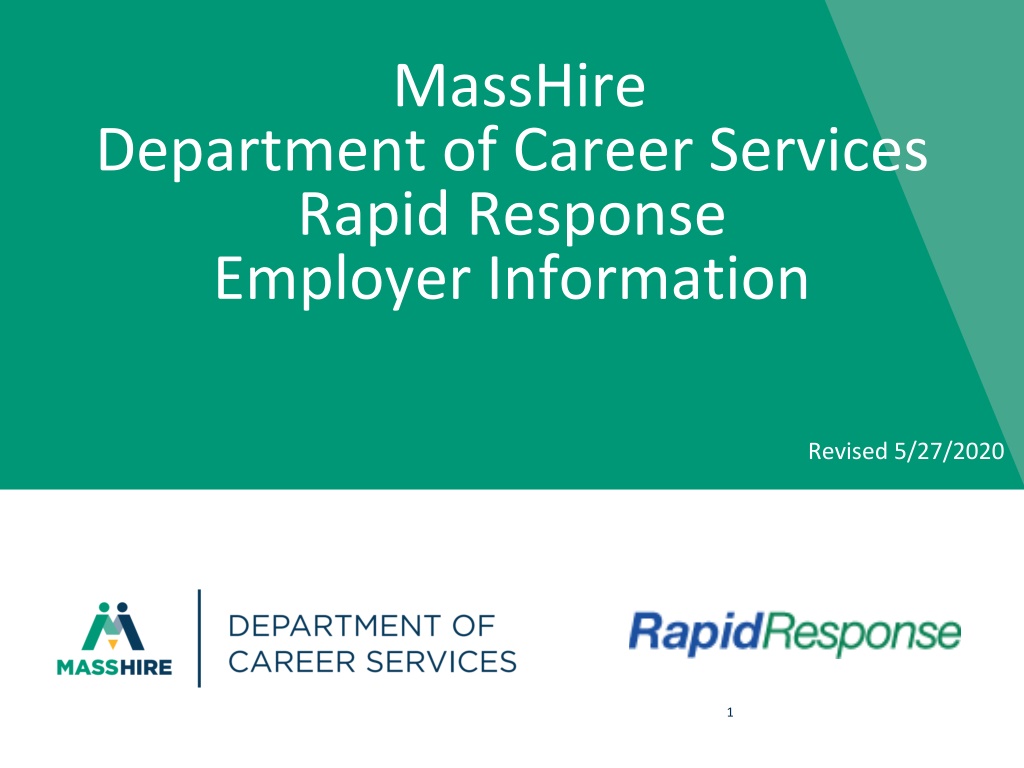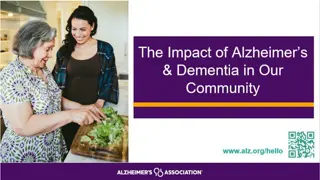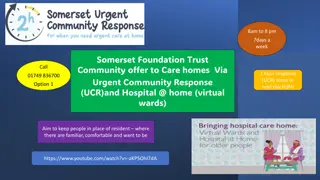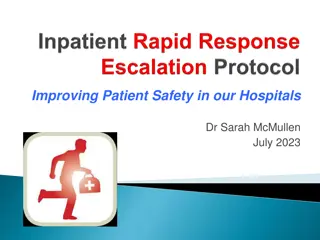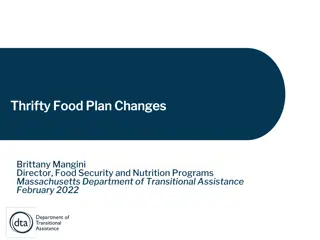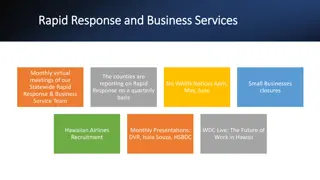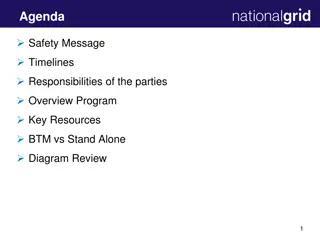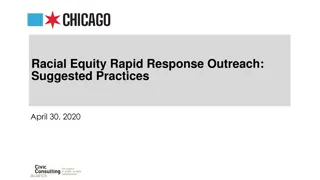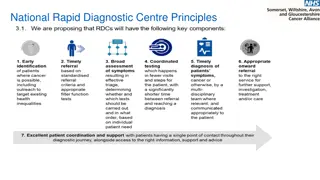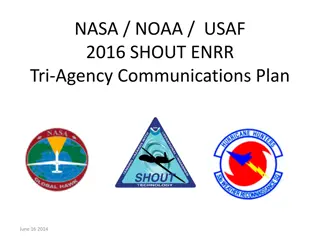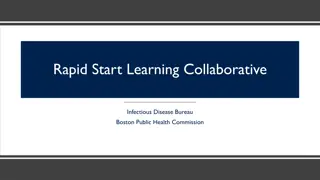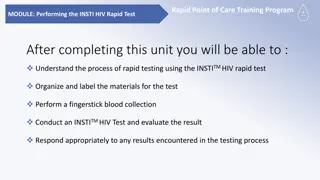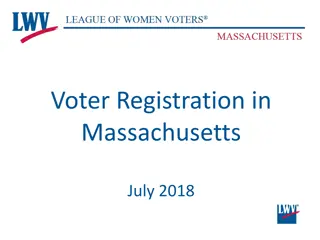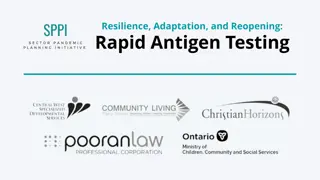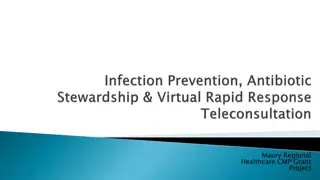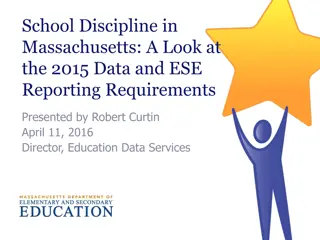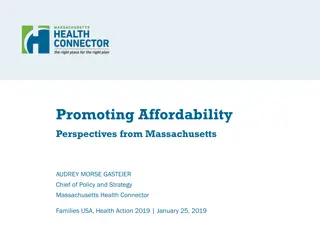Rapid Response Resources for Massachusetts Businesses
This content provides comprehensive information on resources available for businesses in Massachusetts during the COVID-19 pandemic. It covers programs like Rapid Response, WorkShare, Families First Act, Worker Adjustment, and Retraining Notification Act, as well as unemployment insurance details. It also outlines guidelines for businesses reopening in Massachusetts and includes information on health insurance, business loans, tax relief measures, and emergency resources.
Download Presentation

Please find below an Image/Link to download the presentation.
The content on the website is provided AS IS for your information and personal use only. It may not be sold, licensed, or shared on other websites without obtaining consent from the author.If you encounter any issues during the download, it is possible that the publisher has removed the file from their server.
You are allowed to download the files provided on this website for personal or commercial use, subject to the condition that they are used lawfully. All files are the property of their respective owners.
The content on the website is provided AS IS for your information and personal use only. It may not be sold, licensed, or shared on other websites without obtaining consent from the author.
E N D
Presentation Transcript
MassHire Department of Career Services Rapid Response Employer Information https://www.mass.gov/masshire-career-centers Revised 5/27/2020 1
Quick Guide to Resources Reopening Massachusetts - general guidance (p.2) Rapid Response is a federally mandated program designed to assist businesses and employees experiencing a layoff or closing with regional teams throughout The Commonwealth (p.6) MassHire Career Centers with statewide locations, the MassHire Career Centers offer a wide array of services for both business and employees (p.10) The WorkShare Program is a resource for layoff aversion, allowing an employer to reduce employee s work hours. A great alternative to laying off employees (p.13) Families First Act providesnew federal resources for Paid Sick Leave and Expanded Family and Medical Leave to enable use of paid leave benefits to avoid layoffs (p.14) Worker Adjustment and Retraining Notification Act (WARN) Federal layoff requirements - exception: a business that could not reasonably foresee circumstances leading to an event; also temporary layoff status (p.16) Unemployment Insurance includes 1) the waived waiting week, 2) the requirement for continued contact with employer about return date, 3) The CARES Act provisions (p.19) The Health Connector -If you need insurance, you may qualify for coverage through the Health Connector if you ve lost coverage from a job (p.21) Business Loans available (p.23): Small Business Association has Express Bridge Loans, Economic Injury Disaster Loans, The Paycheck Protection Program, and Debt Relief Massachusetts Administrative Tax Relief Measures include postponing the collection of regular sales tax, meals tax, and room occupancy tax until June 20th, 2020 (p.30) Additional Emergency Resources include: MEMA, U.S. Chamber of Commerce, MassMEP, and M-ERT (p.31) Listed within the Appendix: Massachusetts Small Business Development Center regional locations, Small Business Association FAQ s, and FFCRA information (p.36) 2
Reopening Massachusetts General business guidance Information to help businesses meet the self-certification requirement to reopen. All businesses must meet these requirements before reopening. Businesses operating to provide Essential Services, as defined in the Governor's March 23, 2020 Executive Order, updated on March 31, April 28 and May 15, may remain open and have until May 25, 2020 to comply with these mandatory safety standards. COVID-19 control plan template Template that satisfies the written control plan requirement for self-certification Compliance attestation poster Poster that customer facing businesses are required to print, 3 sign, and post in an area within the business premises that is visible to workers and visitors
Reopening: When can my business reopen? Detailed industry reopening plan The following detailed commentary is related to the Executive Order signed by Governor Baker on May 18, 2020. This document is intended to provide additional information on businesses and activities summarized in the Reopening Massachusetts report. This is not an exhaustive list of all possible businesses that can open in each phase; it may be updated from time to time. Unless otherwise stated, businesses expected to be allowed to open in future phases will be subject to certain limitations and guidelines that will be provided at a later date. All businesses are required to follow Mandatory Workplace Safety Standards and Sector specific safety protocols and best practices. All of this information is subject to revision based on the latest public health data. 4 https://www.mass.gov/info-details/reopening-when-can-my-business-reopen
Options for Businesses Experiencing a Downturn Furloughs - Your business is experiencing temporary layoffs. Layoffs - Your business experiences a permanent layoff situation. WorkShare - Your business needs to reduce work hours of your employees. 5
What is MassHire Department of Career Services Rapid Response? Rapid Response is a federally mandated program through the Workforce Innovation Opportunities Act (WIOA) designed to assist businesses and employees experiencing a layoff or closing. The MassHire Rapid Response Team is a business service of the MassHire Department of Career Services. Before your employees are separated from your company, the MassHire Rapid Response Team will provide them with options prior to a layoff and refer them to a MassHire Career Center of their choice. 6
For Assistance with Rapid Response Services Quick Links and Contacts Statewide Office Ken Messina Business Services Manager/Rapid Response Hurley Building 19 Staniford Street, 1st Floor Boston, MA 02114 (617) 626 5703 Office ken.messina@detma.org Mass.gov/Rapid-Response (800) 252-1591 Mass.gov/dua/WorkShare (617) 626-6877 Boston/Metro North Region Chuck Bennett Rapid Response Coordinator II MassHire Metro North Career Center 186 Alewife Brook Parkway Cambridge, MA 02138 (617) 620-4695 charles.bennett@detma.org Mass.gov/unemployment- insurance-ui-for-employers (617) 626-5075 *Certificate of Good Standing is required for the WorkShare program 7
For Assistance with Rapid Response Services Central Region Sandra Foley Rapid Response Coordinator II MassHire North Central Career Center 100 Erdman Way, Leominster, MA 01453 (617) 438-7894 sandra.foley@detma.org Southeast Region Helder Teixeira Rapid Response Coordinator II MassHire Taunton Career Center 72 School Street, Taunton, MA 02301 (508) 977-1421 helder.teixeira@detma.org Northeast Region Norca Disla-Shannon, M.Ed. Rapid Response Coordinator II MassHire Merrimack Valley Career Center 255 Essex Street, Lawrence, MA 01840 (978) 722-7013 norca.disla-shannon@detma.org Western Region Carol Snyder Rapid Response Coordinator II MassHire Springfield Career Center 95 Liberty Street, Springfield, MA 01103 (617) 438-7896 carol.snyder@detma.org 8
What to Expect Working with Rapid Response While you may not be able to change the business conditions that make layoffs necessary, calling the MassHire Department of Career Services (MDCS) Rapid Response Team can reduce the cost of layoffs for you and your employees. In working with Rapid Response, you can expect: A quick response to your transition planning needs Confidentiality Information about alternatives that may reduce or avoid the layoff, or possible future layoffs Pre-layoff services designed to help workers shorten their transition time Information on MassHire Career Centers and Unemployment Insurance Assistance in maintaining worker morale and productivity during the transition Assistance in preparing affected workers to find new employment Coordination with AFL-CIO Rapid Response Team members for union employees 9
MassHire Career Centers The Rapid Response team assists companies with the support of the the MassHire Career Center regionally. MassHire Career Center Business Service Representatives are ready to help and coordinate with the Rapid Response Team. Give the Career Center a call or visit their website: mass.gov/masshire-career-centers/locations 10
Layoff Aversion Services 12
Department of Unemployment Assistance WorkShare Program If your company needs to reduce payroll costs because of a temporary decline in business, the WorkShare program is your alternative to layoffs. WorkShare allows an employer to reduce the work hours of employees in an entire company or individual units/departments. The employees receive unemployment benefits to supplement their reduced wages. Visit mass.gov/workshare-for-employers or call (617) 626-6877 for more information. 13
Additional Resources for Business and Employees New federal resources in the Families First Act on Paid Sick Leave and expanded Family and Medical Leave enabling use of paid leave and avoiding layoffs. https://www.dol.gov/agencies/whd/pandemic/ffcra-employer-paid-leave USDOL just released FAQs and Fact Sheets on sick/paid family leave. https://www.wwlp.com/news/health/coronavirus-local-impact/u-s-department- of-labor-release-info-on-paid-sick-leave-expanded-family-and-medical-leave/ 14
Layoffs 15
Worker Adjustment and Retraining Notification Act (WARN) The Worker Adjustment and Retraining Notification Act (WARN) requires employers give full- and part-time workers written notice 60 calendar days prior to a layoff or company closing. WARN gives workers adequate time to seek new jobs or enter training programs for new skills before losing their current jobs. 16
Who is Covered Under WARN? Private for-profit businesses, private non-profit organizations or public and quasi-public entities separately organized from the regular government that employ at least 100 full time salaried or hourly workers must give notice of covered company closings or mass layoffs. A covered company closing occurs when an employer lays off or terminates at least 50 workers at a company called a single site of employment or at a facility or operation within the plant. An employer must give notice if there is to be a mass layoff which does not result from a company closing, but which will result in an employment loss at the work site during any 30-day period for 500 or more employees, or for 50- 499 employees if they make up at least 33% of the employer s active workforce. 17
Exceptions to WARN Notification Businesses are not required to submit a WARN notification if: They are actively seeking capital, or would save or postpone the need to shut down or lay off people, and believe that advance notice may hurt their ability to find such resources. A business that could not reasonably foresee circumstances leading to the event. Layoffs and closings that are the result of a natural disaster. Visit https://www.doleta.gov/layoff/warn/ for more information. 18
COVID-19 Unemployment Insurance Benefits The Executive Office of Labor and Workforce Development (EOLWD) and the Department of Unemployment Assistance (DUA) made changes to unemployment eligibility to assist workers and employers related to COVID-19. DUA may pay unemployment benefits if a worker is: Quarantined due to an order by a civil authority or medical professional, or leaves employment due to reasonable risk of exposure or infection or to care for a family member Impacted because their workplace is shut down due to COVID-19 DUA can excuse missed deadlines during the processing of a claim, such as responding to fact-finding questionnaires and requesting an appeal, if the reason for failing to meet the deadline is due to COVID-19. DUA can grant employer requests for extensions for filing quarterly wage reports and paying contributions. General UI Resources: mass.gov/unemployment/covid-19 Employer FAQs: mass.gov/info-details/employer-unemployment-faq-covid-19 Employee FAQ: mass.gov/info-details/employee-unemployment-faq-covid-19 19
"CARES Act" - Federal Coronavirus Aid Unemployment Insurance Provisions Creates a new Pandemic Unemployment Assistance program (through December 31, 2020) to help those not traditionally eligible for Unemployment Insurance (UI), including self-employed individuals, independent contractors, those with limited work history and those who are unable to work as a result of the Coronavirus public health emergency. www.mass.gov/pua Provides additional $600/week payment to each UI or Pandemic Unemployment Assistance recipient through the end of July 2020. Provides an additional 13 weeks of unemployment benefits to help those who remain unemployed after state unemployment benefits run out. Provides states with temporary, limited flexibility to hire temporary staff, or re- hire former staff, to more efficiently process unemployment claims. 20
Massachusetts Health Connector If you need health insurance, you may qualify for coverage through the Health Connector. An extended enrollment period is available through May 25, 2020 in response to the COVID-19 outbreak. Apply today and get covered. For more detailed information please go to: https://www.mahealthconnector.org/the -right-plan-right-now 21
Small Business Administration Express Bridge Loans Express Bridge Loan Pilot Program allows small businesses who currently have a business relationship (i.e. account or loan) with an SBA Express Lender to access up to $25,000 with less paperwork. These loans can: Help overcome the temporary loss of revenue Work as term loans or used to bridge the gap while applying for a direct SBA Economic Injury Disaster loan If a small business has an urgent need for cash while waiting for a decision and disbursement on an Economic Injury Disaster Loan, they may qualify for an SBA Express Disaster Bridge Loan. Terms: Up to $25,000 Fast turnaround Will be repaid in full or in part by proceeds from the EIDL loan Find an Express Bridge Loan Lender via SBA s Lender Match Tool or by connecting with your local SBA District Office 23
Accessing SBAs Economic Injury Disaster Loan (EIDL) U.S. Small Business Administration (SBA) will offer low-interest federal disaster loans for working capital to Massachusetts small businesses suffering substantial economic injury as a result of the Coronavirus (COVID-19). UPDATE MAY 8,2020: SBA will begin accepting new Economic Injury Disaster Loan (EIDL) and EIDL Advance applications on a limited basis only to provide relief to U.S. agricultural businesses. The new eligibility is made possible as a result of the latest round of funds appropriated by Congress in response to the COVID-19 pandemic. Agricultural businesses includes those businesses engaged in the production of food and fiber, ranching, and raising of livestock, aquaculture, and all other farming and agricultural related industries (as defined by section 18(b) of the Small Business Act (15 U.S.C. 647(b)). SBA is encouraging all eligible agricultural businesses with 500 or fewer employees wishing to apply to begin preparing their business financial information needed for their 24 application.
The Paycheck Protection Program The PPP is a loan program designed to provide a direct incentive for small businesses to keep workers on the payroll. Loans are up to $10M, with a 0.5% interest rate and a 2-year maturity; there are no payments for the first 6 months. Who can apply? Businesses, nonprofits, Veterans organizations, Tribal concerns, sole proprietorships, self-employed individuals, and independent contractors, with 500 or fewer employees. What else should I know? The SBA will forgive loans if all employees are kept on the payroll for 8 weeks and the money is used for payroll, rent, mortgage interest, or utilities. The program will be available retroactive from Feb. 15, 2020, so employers can rehire their recently laid-off employees through June 30, 2020. Although generally borrowers are expected to restore their employee base, the application notes 4 reasons for which borrowers won t be penalized in the forgiveness calculation related to their headcount. Those include: a. Employees who declined to return; b. Employees who were fired for cause; c. Employees who voluntarily resigned, and; d. Employees who requested and received a reduction in their hours. SBA PPP Frequently Asked Questions Link 25
Massachusetts Growth Capital Paycheck Protection Program Support Massachusetts Growth Capital Corporation (MGCC) in partnership with Massachusetts Association of Community Development Corporation (MACDC) announced support for all Massachusetts small businesses owners, including those with limited English proficiency, by providing multilingual translation and application assistance for the Small Business Administration s (SBA) Paycheck Protection Program (PPP). All small businesses in Massachusetts are strongly encouraged to use these resources when applying to the second round of PPP at their local, participating bank once available. https://www.empoweringsmallbusiness.org/resources/covid-19-small- business-resources Languages include: Spanish, Portuguese, Mandarin, Cantonese, French, French Creole, Italian, Russian, Vietnamese, Greek, Arabic, Cambodian, Somali, Amharic 26 (Ethiopian), Filipino, Nepalese, Korean, Japanese and Thai
SBA Debt Relief The SBA is also offering Debt Relief to small businesses. Under this relief, the SBA will pay the principal and interest for 6 months beginning March 27, 2020 for qualifying new and current holders of 7(a) loans. Who can apply? Businesses who already have a covered 7(a) SBA loan or receive a 7(a) SBA loan prior to September 27, 2020. When can I apply? This relief is applied for covered loans beginning with payments due after March 27, 2020. How do I apply? Reach out to your SBA lender to discuss how this debt relief applies to your SBA loan. What else should I know? This debt relief is available only to 7(a) loans and not to loans made under the Paycheck Protection Program, 504 loans, or micro- loans. Read more here: sba.gov/page/coronavirus-covid-19-small-business- guidance-loan-resources#section-header-4 27
Main Street Lending Program Federal Reserve The Federal Reserve designed Main Street to support small and medium sized businesses that were unable to access the PPP or that require additional financial support after receiving a PPP loan. Main Street loans are not forgivable. The Federal Reserve Board on Thursday, April 30, 2020, announced it is expanding the scope and eligibility for the Main Street Lending Program. As part of its broad effort to support the economy, the Federal Reserve developed the Main Street Lending Program to help credit flow to small and medium-sized businesses that were in sound financial condition before the pandemic. 28 https://www.federalreserve.gov/
Small Business Relief Partnership Grant Program The Attorney General s Small Business Relief Partnership Grant Program will provide funding to municipalities and regional planning agencies who are assisting small businesses in the communities they serve. Grant funds will be distributed by these organizations to help small business address fixed debt, payroll, accounts payable, lost sales, lost opportunities, and other working capital expenses incurred by the COVID-19 pandemic. The AG s Office also recently contributed $50,000 to the City of Boston s Small Business Relief Fund, which provides financial support to small businesses in Boston. This grant was funded by settlement funds secured by the AG s Office. Grant awards will be issued in varying amounts up to $500,000, and individual requests may not exceed $50,000. As a condition of receiving the grant, all funds must be distributed directly to small business, and 29 no portion of these funds may be used to defray administrative or operational costs. Grants
Administrative Tax Relief Measures Massachusetts Administrative Tax Relief Measures for small local businesses that have been impacted by the ongoing COVID-19 outbreak, especially in the restaurant and hospitality sectors. This tax relief includes postponing the collection of regular sales tax, meals tax, and room occupancy taxes that would be due in March, April, and May so that they will instead be due on June 20. Additionally, all penalties and interest that would otherwise apply will be waived. Businesses that paid less than $150,000 in regular sales plus meals taxes in the year ending February 29, 2020 will be eligible for relief for sales and meals taxes. Businesses that paid less than $150,000 in room occupancy taxes in the year ending February 29, 2020 will be eligible for relief with respect to room occupancy taxes. 30
Additional Emergency Resources 31
Additional Emergency Resources Massachusetts Emergency Management Agency(MEMA) ensures the state is prepared to withstand, respond to, and recover from all types of emergencies and disasters. MEMA s Emergency Operations Center s Private Sector Hotline The hotline will be staffed Monday Friday from 8am to 4pm The number for the hotline is (508) 820-2094 mass.gov/orgs/massachusetts-emergency-management-agency The U.S. Chamber also has resources available to inform and equip businesses with the most important and up-to-date information to prevent the spread of the virus and prepare businesses for the near and long-term impact. uschamber.com/ 32
MassMEP All of the state Manufacturing Extension Partnerships, including the one in Massachusetts, have formed a national network to offer supply chain solutions to the manufacturers disrupted by the efforts to stem the spread of Coronavirus. The network, launched in March, enables MEPs in any state to put out a call on behalf of one of its manufacturers to find creative solutions to issues like supply shortages. MEPs are public-private partnerships in all 50 states funded, in part, by the U.S. government to provide advocacy and services like education and training to individual companies. MassMEP Phone: (508) 831-7020 https://massmep.org/ 33
Manufacturing Emergency Response Team(M-ERT) The M-ERT s Mission: To mobilize, organize, and operationalize critical-path work streams necessary for Massachusetts manufacturers to pivot their operations to produce needed materials in response to the COVID-19 pandemic. If your organization is interested in joining the effort, please fill out the form located at https://masstech.org/M-ERT and an M-ERT member will reach out. If your organization is NOT located in Massachusetts, we invite you to fill out this form as well. This information will be critical for coordinating parallel efforts of other state and federal initiatives. Only one response per organization should be submitted. Please coordinate a central contact for organizing your company s response. Organizational contacts should be available to coordinate the deployment of production assets, testing assets, and/or represent the entity. If the person completing the form is not this person, there is space provided for additional contact information. 34
*Disclaimer Information in this presentation is changing rapidly and we are updating it regularly. Many programs and services are changing quickly depending on funding availability so be sure to contact the individual resource for up-to-the-minute information. Check back to our Rapid Response or BizWorks pages at www.Mass.Gov for updated information periodically. 35
Appendix 36
Massachusetts Small Business Development Centers Massachusetts Small Business Development Center advisors can assist businesses with disaster loan applications. If you are not currently a client and would like to speak with a counselor, please reach out to the regional office nearest to you: Procurement Technical Assistance Center Scibelli Enterprise Center 1 Federal Street, Building 1 Springfield, MA 01105 (413) 545-6303 | Fax: (413) 737-2312 massptac.org 37
Massachusetts Small Business Development Centers Southeast Regional Office 200 Pocasset Street Fall River, MA 02721 (508) 673-9783 | Fax: (508) 674-1929 msbdc.org/semass Berkshire Regional Office 33 Dunham Mall, Suite 103 Pittsfield, MA 01201 (413) 499-0933 | Fax: (413) 499-3005 msbdc.org/berkshire Central Regional Office Clark University The Carriage House, 125 Woodland Street Worcester, MA 01610 (508) 793-7615 | Fax: (508) 793-8890 clarku.edu/offices/sbdc Western Regional Office Scibelli Enterprise Center One Federal Street, Building 101 Springfield, MA 01105-1160 (413) 577-1768 | Fax: (413) 737-2312 msbdc.org/wmass Northeast Regional Office Salem State University 121 Loring Avenue, Suite 310 Salem, MA 01970 (978) 542-6343 | Fax: (978) 542-6345 salemstate.edu/sbdc 38
SBA FAQs If I am applying or already received an Economic Injury Disaster Loan, is my small business eligible to participate in the Paycheck Protection Program(PPP)? - Borrowers can apply for BOTH an Economic Injury Disaster Loan and the Paycheck Protection Program loan. However, the Paycheck Protection Program loan funds and the Economic Injury Disaster Loan funds cannot be used for the same purpose. - The Paycheck Protection Program loan must be used for payroll (minimum of 75% of the funds received) for it to be eligible for a forgivable loan and the remaining 25% can be used for different purposes (mortgage interest, rent, utilities, other services). - Borrowers who accept both loan funds should document the uses of the funds appropriately. 39
SBA FAQs If your Economic Injury Disaster Loan was used for payroll costs, your Paycheck Protection Program(PPP) loan must be used to refinance your Economic Injury Disaster Loan. Any advance up to $10,000 on the Economic Injury Disaster Loan will be deducted from the loan forgiveness amount of the Paycheck Protection Program loan. - For example, a borrower may obtain a loan from the Paycheck Protection Program and use those funds to pay for 8 weeks of payroll or employee retention. They may wish to then dedicate their entire EIDL funds towards working capital, notes payable and accounts payable that do not duplicate the funds provided through the Paycheck Protection Program. If the EIDL loan was used for payroll expenses, the borrower must refinance the EIDL loan with the PPP loan which carries a lower interest rate as well as a shorter maturity period. If you are applying for both, you can accept PPP first then decide whether or not to close on your EIDL approved loan. 40
SBA FAQs The application period for PPP loans runs through June 30, 2020, but the EIDL application period runs through December 2020. If you did not apply through the streamlined process, SBA requests that you visit https://covid19relief.sba.gov/#/ and reapply with the secure streamlined process. You will not lose your place in queue with your original EIDL loan application. EIDL loans will not require a personal guarantee for loans under $200,000. EIDL loans will not require real estate collateral for loans under $500,000. SBA will be looking at the best available lien priority on all business assets. 41
PPP Guidance for Employees Refusing to Return to Work The Small Business Administration (SBA) recently issued new guidance regarding the Payment Protection Program (PPP), established to offset the economic effects of the coronavirus pandemic. Small businesses can request loans from the PPP to help cover payroll costs. This new guidance from the SBA concerns employees who refuse to return to work after a business reopens. Background Small businesses can request loans from the PPP to be used as wages for employees, up to 2.5 times the average monthly payroll. Using the funds this way makes the loan entirely forgivable. The catch is that the business must rehire the same number of full-time employees that it used to calculate the PPP loan amount. The problem is that many employers don t necessarily need all those staff members to return, especially if operations have been slowed. Furthermore, some employees may not even want to return and not necessarily for coronavirus concerns. Some employees might be making more with unemployment benefits and don t want to lose them by returning to work. 42
PPP Guidance for Employees Refusing to Return to Work What s New The SBA understands some employees may not wish to return for a number of reasons, so it issued new guidance. As long as businesses make a good faith effort to rehire employees and explain that they may lose their unemployment eligibility by not returning the businesses would not face a penalty under that portion of the loan. Employers should carefully document any communication with employees in case they refuse to return to work and evidence is needed when requesting PPP loan forgiveness. Read the full text of the guidance below: Question: Will a borrower s PPP loan forgiveness amount (pursuant to section 1106 of the CARES Act and SBA s implementing rules and guidance) be reduced if the borrower laid off an employee, offered to rehire the same employee, but the employee declined the offer? Answer: No.As an exercise of the Administrator s and the Secretary s authority under Section 1106(d)(6) of the CARES Act to prescribe regulations granting de minimis exemptions from the Act s limits on loan forgiveness, SBA and Treasury intend to issue an interim final rule excluding laid-off employees whom the borrower offered to rehire (for the same salary/wages and same number of hours) from the CARES Act s loan forgiveness reduction calculation. The interim final rule will specify that, to qualify for this exception, the borrower must have made a good faith, written offer of rehire, and the employee s rejection of that offer must be documented by the borrower. Employees and employers should be aware that employees who reject offers of reemployment may forfeit eligibility for continued unemployment compensation. For more information, visit SBA.gov. 43
Families First Coronavirus Relief Act (FFCRA) Which employers are covered by the FFCRA? - The FFCRA covers certain public employers and all private employers with fewer than 500 employees. - For purposes of this count, employers must include all full-time and part-time employees in the U.S. (or any U.S. territory or possession), including any employees who are on leave, as well as temporary employees and day laborers supplied by an agency (with limited exceptions). - Independent contractors need not be counted, but employers who may be a joint employer with another business or are owned even in part by another entity should consider consulting an employment attorney for additional guidance. 44
Families First Coronavirus Relief Act (FFCRA) Are any employers exempt from the FFCRA? - Small businesses with fewer than 50 employees may qualify for exemption from the requirement to provide sick time or FMLA leave due to school closings or the unavailability of childcare if doing so would jeopardize the viability of the business as a going concern. Regulations outlining this exemption are expected to be published by the Department of Labor in April. When does this go into effect, will this leave be available forever, and do we need to notify employees? - The law is effective April 1, 2020, and expires on December 31, 2020. And, yes, employers are required to post a notice in the workplace on the FFCRA requirements in a conspicuous place. https://www.dol.gov/agencies/whd/pandemic/ffcra-employer-paid-leave 45
Families First Coronavirus Relief Act (FFCRA) How are we going to pay for this? - Important question! Qualified employers that pay sick leave will receive a dollar-for-dollar reimbursement through tax credits for all qualifying wages paid under the FFCRA, up to the appropriate daily and aggregate payment caps. Here s how the IRS explained it will work: - If an eligible employer paid $5,000 in sick leave and is otherwise required to deposit $8,000 in payroll taxes, including taxes withheld from all its employees, the employer could use up to $5,000 of the $8,000 in taxes it was going to deposit for making qualified leave payments. The employer would only be required under the law to deposit the remaining $3,000 on its next regular deposit date. - If an eligible employer paid $10,000 in sick leave and was required to deposit $8,000 in taxes, the employer could use the entire $8,000 of taxes in order to make qualified leave payments and file a request for an accelerated credit for the remaining $2,000. 46
Families First Coronavirus Relief Act (FFCRA) What new rights does the FFCRA provide to employees? The FFCRA requires covered employers to provide the following to all employees: Two weeks (up to 80 hours) of paid sick leave at the employee s regular rate of pay if the employee is unable to work or telework because the employee (1) has been quarantined (either by government order or on the advice of a healthcare provider) and/or (2) is experiencing COVID-19 symptoms and seeking a medical diagnosis. Employees will be paid their full wages, up to a maximum of $511 per day ($5,110 total) for these sick-leave reasons; and Two weeks (up to 80 hours) of paid sick leave at two-thirds the employee s regular rate of pay if the employee is unable to work or telework because the employee (1) must care for someone who has been quarantined (again, either by government order or on the advice of a healthcare provider), (2) must care for a minor child whose school or childcare provider is closed or unavailable due to the virus, and/or (3) is experiencing a substantially similar condition, which has yet to be defined but will be the subject of regulations to be issued by the Department of Health and Human Services. Employees will be paid two- thirds of their wages up to a maximum of $200 per day ($2,000 total) for these sick-leave reasons. Employees who have been employed by a covered employer for at least 30 days may also take an additional 10 weeks of paid leave at two-thirds their wages to continue to provide care for a minor child whose school or childcare provider remains closed or unavailable due to the virus. This also caps out at $200 per day. 47
